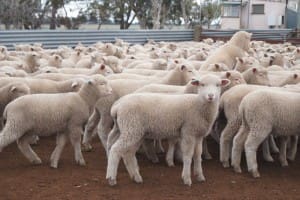ANIMAL Ethics, the developers of the Tri-Solfen pain relief product used in mulesing sheep, has released a set of statistics which indicate strong uptake of pain relief options in most parts of Australia.
The figures released this morning are based on Australian Wool International’s breech surgery statistics for the 2013/2014 year, compared with the updated volumes of Tri-Solfen sales in each State for the 2014 Australian lamb marking season.
The percentage of Merino lambs treated with Tri-Solfen 2014, based on a single dose rate per lamb sold against state lamb numbers receiving breech surgery for prevention of flystrike included:
- South Australia 81.89 percent
- Victoria/Tasmania 71.83pc
- New South Wales 65.32pc
- Western Australia 55.5pc
- Queensland 16.26pc
NumNuts pain relief on the market within 18 months
Meanwhile in other news developments in the pain relief field, MLA says the NumNuts castration and tail-docking tool will play a serious role in providing pain relief during animal husbandry practices within the next 18 months.
 The hand-held tool, which is currently being commercialised and is expected to be for sale by mid-2017, features a single action castration/tail docking ring applicator and injection mechanism which administers the local anaesthetic lignocaine (used by the dental industry) for rapid pain relief.
The hand-held tool, which is currently being commercialised and is expected to be for sale by mid-2017, features a single action castration/tail docking ring applicator and injection mechanism which administers the local anaesthetic lignocaine (used by the dental industry) for rapid pain relief.
NumNuts is the result of a partnership between MLA and Scottish engineering firm 4cDesigns, which was established during the MLA-funded development of a barber’s pole worm vaccine, BarberVax, by Moredun Research Institute in Scotland.
Australian Wool Innovation also contributed to the project, with research by Moredun and the CSIRO.
“Our goal was to develop a pain relief tool which could be used on-farm by producers, without the need for a veterinarian’s skills,” MLA’s Program Manager for Animal Health, Welfare and Biosecurity, Jim Rothwell, said.
“It gives producers a practical and economic solution in response to community concerns about the necessary husbandry practices of castration and tail docking and demonstrates the industry is embracing best practice.”
The anaesthetic acts about 30 to 60 seconds after injection and doesn’t wear off for around four hours, by which time the tissue in the testes and tail are dead, eliminating residual pain.
In proof-of-concept trials, there was a significant decrease in pain behaviour such as ‘tucked up’ posture, bleating and lying down.
The tool is designed for lambs aged two to 12 weeks, which reflects the new Australian Animal Welfare Standards and Guidelines for sheep and cattle: pain relief is desirable if practical and cost effective, recommended for animals over three months of age and required for animals over six months of age.
It is expected to cost around 20¢/treatment.
Proof-of-concept trials are now underway for a cattle castration version of NumNuts, and MLA is also funding research to set the minimum residue levels of lignocaine, which will determine any meat withholding periods.
Source: MLA

I’m trying to find more about the applicator of NumNuts and Tri-Solfen. Can you tell me if I can get one or when it will become available? Thanks
No surprise that WA and QLD are behind the rest of sheep-producing states. So what about teeth cutting, ear notching and tagging, tail docking and castration in pigs? What about turkey toe cutting and chicken de-beaking? What about de-horning and disbudding of cattle? The list of surgical procedures/mutilations performed on farmed animals under the guise of animal husbandry and without anaesthetic and/or pain relief is endless. All procedures would see one charged with animal cruelty if done to a dog or cat without anaesthetic/pain relief. The same should apply to animals used in animal agriculture; they don’t suddenly feel less pain than companion animals because they are deemed “livestock”. In fact, if the recent discovery that horses’ skin is more sensitive than human skin is anything to go by, they quite possibly feel more pain.